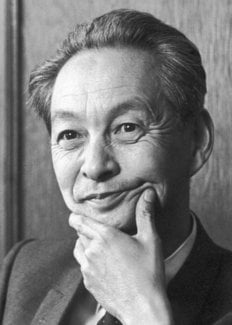Sin-Itiro Tomonaga
Biographical

Sin-Itiro Tomonaga was born in Tokyo, Japan, on March 31, 1906, the eldest son of Sanjuro Tomonaga and Hide Tomonaga. In 1913 his family moved to Kyoto when his father was appointed a professor of philosophy at Kyoto Imperial University. From that time he was brought up in Kyoto. He is a graduate of the Third Higher School, Kyoto, a renowned senior high school which has educated a number of leading personalities in prewarJapan.
Tomonaga completed work for Rigakushi (bachelor’s degree) in physics at Kyoto Imperial University in 1929, with one of his intimate friends. Dr. Hideki Yukawa, Nobel laureate. He was engaged in graduate work for three years at the same university and was then appointed a research associate by Dr. Yoshio Nishina at the Institute of Physical and Chemical Research, Tokyo, where he started to work in a newly developed frontier of theoretical physics quantum electrodynamics – under the guidance of Dr. Nishina. His paper on the photoelectric pair creation is well-known.
Tomonaga stayed in Leipzig, Germany, from 1937 to 1939, to study nuclear physics and the quantum field theory in collaboration with the theoretical group of Dr. W. Heisenberg, where he published a paper “Innere Reibung und Wärmeleitfähigkeit der Kernmaterie”, which was chosen as the thesis for Rigakuhakushi (Doctor of Science) at Tokyo Imperial University in December,1939.
In 1940, Dr. Tomonaga directed his attention to the meson theory and developed the intermediate coupling theory in order to clarify the structure of the meson cloud around the nucleon. He joined the faculty of Tokyo Bunrika University (which was absorbed into the Tokyo University of Education in 1949*) as Professor of Physics in 1941. It was in 1942 when he first proposed the covariant formulation of the quantum field theory in which the concept of the quantum state was generalized so as to be relativistically covariant.
During the Second World War, Dr. Tomonaga was interested in developing a theory of microwave systems. He solved the motion of electrons in the magnetron and also developed a unified theory of the systems consisting of wave guides and cavity resonators.
As soon as the War was over, Tomonaga came back to academic research again with a programme in which he was first to summarize and extend the intermediate coupling theory and secondly to apply the covariant field theory to actual physical systems. His aim was to investigate the nature of field reaction in the meson theory as well as in quantum electrodynamics. He was confident, prior to the Lamb-Retherford experiment, by means of a model calculation that divergence difficulty in quantumelectrodynamics could be overcome simply by handling the infinite mass and charge due to field reactions in some way or another. It was only a step further for him to develop the renormalization theory with covariant formalism in his right hand and experimental support in his left.
Dr. Tomonaga was invited to the Institute for Advanced Study, Princeton, in 1949 where he was engaged in the investigation of a one-dimensional fermion system. Thus he first succeeded in clarifying the nature of collective oscillations of a quantum-mechanical many-body system and opened a new frontier of theoretical physics, modern many-body problem. In 1955, he published an elementary theory of quantum mechanical collective motions.
Dr. Tomonaga took the leadership in establishing the Institute for Nuclear Study, University of Tokyo, in 1955. From 1956 to 1962 he was appointed President of the Tokyo University of Education and since 1963 he has been President of the Science Council of Japan and Director of the Institute for Optical Research, Tokyo University of Education. He occupies an important position in various governmental committees for scientific research and policymaking.
Tomonaga’s honours and awards include the Japan Academy Prize (1948); the Order of Culture (1952); the Lomonosov Medal, U.S.S.R. (1964).
Dr. Tomonaga is a member of the Japan Academy, the Deutsche Akademie der Naturforscher “Leopoldina” and a foreign member of the Royal Swedish Academy of Science. He is a corresponding member of the Bayerische Akademie der Wissenschaften and a foreign associate of the National Academy of Science of U.S.A.
Tomonaga has published widely in scientific journals on such subjects as quantum electrodynamics, the meson theory, nuclear physics, cosmic rays, and the many-body problem. His book, “Quantum Mechanics”, was published in 1949 and translated into English in 1963.
Tomonaga was married in 1940 to Ryoko Sekiguchi, daughter of Dr. K. Sekiguchi, the former Director of the Tokyo Metropolitan Observatory. They have two sons, Atsushi and Makoto and one daughter. Their daughter was married in 1965 to Dr. Y. Nagashima, research associate of the Physics Department, University of Rochester.
This autobiography/biography was written at the time of the award and first published in the book series Les Prix Nobel. It was later edited and republished in Nobel Lectures. To cite this document, always state the source as shown above.
* Tokyo University of Education was further reorganized and renamed as University of Tsukuba in 1973.
Sin-Itiro Tomonaga died on July 8, 1979.
Nobel Prizes and laureates
Six prizes were awarded for achievements that have conferred the greatest benefit to humankind. The 14 laureates' work and discoveries range from quantum tunnelling to promoting democratic rights.
See them all presented here.
